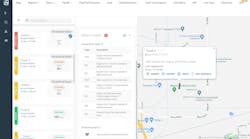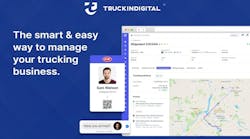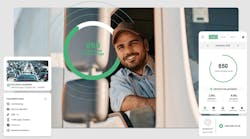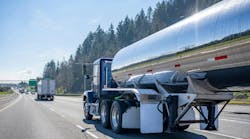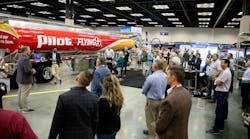IN 2014, Frost & Sullivan addressed video event systems, projecting that an “optimistic growth rate” would mean that there would be 635,000 by 2017. That number has been reached.
So why is there such tremendous interest in these devices?
“There’s a strong return on investment,” said Rob Abbott of Lytx, “and that comes from auto liability claims, vehicle repairs, and workers compensation claims. It’s also important to understand there is some benefit—modestly, but some benefit—in terms of improvement in fuel economy. There also is a reduction in maintenance costs that comes from coaching drivers, smoother driving, and an increase in miles per gallon.”
Abbott was the moderator for a panel session entitled “Video Event Systems Benefits and Considerations” that was presented during the 2017 National Tank Truck Carriers Tank Truck Safety & Security Council Annual Meeting. The panelists: John Bowlby, director of safety and compliance for Carbon Express Ltd; Candi Coate, director of safety and compliance for K-Limited Carrier Ltd; and Randy Kopecky, Transwood Carriers Inc.
Abbott said the benefits of on-board camera systems really come out of two markets:
• Exoneration video and post-crash litigation. “There’s the potential that after a crash, you will have a video that demonstrates your driver is vindicated. That is why a lot of people showed a lot of interest early.”
• Behavior change and crash prevention. “Fleets found that there was an equal or greater benefit in using film to coach drivers and improve behavior. We know risky behavior begets near misses and minor crashes, which beget major crashes.”
How do they work?
“Most common devices in the trucking industry today are constantly recording but generally overwriting,” Abbott said. “So they’re not keeping the data unless something happens and triggers the device to keep the video.”
The trigger comes from a number of sources:
• Accelerometers. “Basically a chip. You have an accelerometer in your car that triggers the air bag. These systems typically use an accelerometer. Whether it’s a force, a hard brake or a crash, it triggers the video capture.”
• Advanced Driver Assistance Systems (ADAS). “There’s also an ability in many systems to trigger video using third-party ADAS systems. If you have collision warning or lane departure in your vehicles, it can often trigger a video.”
• Machine vision/artificial intelligence. “There are newer generations of providers that are operating machine vision/ artificial intelligence that is looking at road markings, road signs, and other vehicles on the roads and triggering based on that. It’s not necessarily what the individual sees on the video—it’s what the device sees. So if it sees a red light and a driver went through the light, it could capture that on video.”
• Manual capture. “The driver pushes a button to say, ‘Hey, I want to capture this risky event in front of me.’ ”
Event capture is the first stage, and then, with most popular systems in the industry today, they get uploaded to the cloud.
“There are some devices where reporting is stored on an SD card in the unit itself,” he said. “Those are less popular in trucking but still available. They are typically used by people who just want evidence of a crash.
“Most of the popular systems are uploaded to the cloud and then there’s a fork in the road. Some providers then provide all videos to the fleet, and the fleet has to review the videos to determine which of them are actionable and then weigh the safety implications for the drivers’ behavior.
“Some providers are taking it a step further, and I won’t make a value judgment of which one is better: By reviewing the videos and filtering out which ones are actionable. You may get a lot of videos based on a hard bump in the road—which really aren’t actionable. And you filter out which ones are meaningful. There’s hard braking because the driver didn’t aim high or didn’t see what was coming. They score them for safety risk. So they might say, ‘This one is a high score because the driver was texting while driving. It’s referred to the fleet, which will typically coach the driver and hopefully improve the driver’s behavior to prevent future crashes.”
For people evaluating systems, there are number of common concerns.
Q: People are concerned about driver reaction to on-board video cameras. What was the reaction your drivers had and how did you mitigate that? Was it as they perceived?
Coate: We began our process months and months before they were used. We researched and gathered all of the information. We decided to go with a 60-day trial period. And before we did that, we had some drivers who volunteered to be part of that trial period. We had another company that we partnered with that came to one of our safety meetings that had already put recorders in, and they shared their stories and answered questions that the drivers had. We were very open with our process. We had an elite group of trainers across our company at all of our terminals. We had event recorders in their trucks and asked for a few volunteers. As they went through this 60-day trial period, they were able to provide us with feedback, and also their peers answering questions they might have about negatives and positives. We haven’t had anyone leave. We have a lot of positives. We’re about 65% installed so far. The key element you have to consider is peer-to-peer involvement. Make sure you have the drivers you can count on being positive about it to share that with the others.
Q: Randy, you’ve been around the industry for a while. You’ve seen how with ELDs, drivers said, “Hey, I’m not going to put this in my truck. I’m going to quit.” I think there was a lot of noise, but when the dust settled, not a lot left the industry. Did you find that with video recorders?
Kopecky: Yeah, we did. Over the course of 2½ years, with each deployment, the operations managers and terminal managers held one-on-ones with drivers to try to dispel as much as possible. We asked those guys, “Hey, give it two weeks, give it a month, and see how it works for you.” We tried to do as much as possible to dispel that. One notable guy left, and three days later his wife brought him back in and said, “You’re not quitting.”
Q: John, you’re very early in your deployment. Have you done anything differently trying to win the drivers over and calm their concerns?
Bowlby: We’re taking it slow. We’re not pushing it down their throat right now. We using the more popular drivers, because once you get them to buy in on it, they’ll start talking to the guys and saying, “It’s not so bad.”
Q: We often hear, particularly from lawyers, that they’re concerned that while there is this great potential, there is also potential it could show the driver was at fault, and it could hurt to have this video evidence. Have you had that concern in your fleet and do you share that?
Coate: I think it’s definitely a concern and something you have to think about and consider, but I think ultimately it’s still going to save the costs of trial and legal fees.
Kopecky: In the past, we had drivers come and say, “Well, I didn’t make a lane change,” and video kind of proves differently. If you know from the film an hour after the accident where you’re at, I think you’re going to look at that case differently and maybe not spend what you would have.
Q: Backing up a step, what caused you to deploy on-board video cameras? Was it your insurance company that said, “Hey, you ought to do this”?
John: What drove us to do it was basically 80% of the car-versus-truck accidents were caused by the car. We all know that. So if I’m going to have odds like that, I’m going to play. It’s the same thing with this. Yes, it can come back and bite us in the butt. We’ve had two DOT reportables this year, and neither one was our fault. Especially in the one case, if we had a camera in that truck, it would have protected us.
Q: A lot of people are concerned that this is going to generate a lot of video events and it’s actual data, and if you had possession of actual data on which you didn’t act, you’re culpable. But does it create a workload for your people and how do you deal with that?
Coate: We have trainers looking at each of our terminals and they’ve been assigned the coaching responsibility for the drivers who have events, both positive and negative. You want to point out the positives when you can and then hit the negatives. The best approach or best way you can really hit home with the driver, I believe, is when you can get a peer-to-peer conversation going where you’ve got the experience and they can see candidly that you’ve been there, done that—versus me sitting in my office, not driving on the road and dealing with what they’re dealing with. We’ve had good response from the drivers that have been coached. We’ve got a retired driver that’s part of our safety department now, and he spends a good chunk of his day looking at the events that have come up and determining what’s coachable and what really doesn’t need to be. We’re still dialing into the system and trying to determine what works best for us. But definitely the peer-to-peer approach we’ve got has been working very well for us.
Q: John, you’re just starting. Who’s going to do the coaching in your organization? Is it somebody in operations?
Bowlby: I’ll be doing that.
Q: So you have how many drivers?
Bowlby: 60 drivers, so we’re on a smaller scale.
Q: So Randy, you’ve done this at some larger fleets. Is a workload manageable and who should be doing this coaching? Operations people, safety people, the drivers?
Kopecky: Both fleets have been 500-plus. The terminal manager at the terminal level does the coaching. It gets kicked up to a third-party review, and they weed down what we need to see. On average for us, per truck, there are about three events a month. When you go further, it’s about 7% of the drivers making up 90% of those events. When you look at that, I had a couple of drivers who had never had a coachable event in 2½ years.
Coate: At the beginning, you’re going to spend significantly more time on the coaching aspect until you can hone in and start changing their behaviors.
